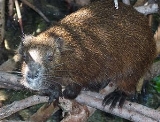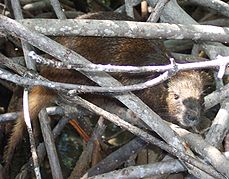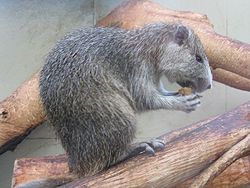
Desmarest's Hutia
Encyclopedia
Desmarest's Hutia, Capromys pilorides, also known as the Cuban Hutia, is a species of hutia
endemic to Cuba
. Growing to 60 cm (24 in), it is the largest of the extant hutia species, and is abundant throughout its range.
which extends to the tip of the tail. The colour of the body fur varies from black to brown, with a light sand colour and red also seen. The body is stocky and the legs short. It moves with a slow, waddling gait, but can perform a quick hop when pursued. The feet have five toes with large claws which assist the animal in climbing. The stomach
is divided into three compartments by constrictions in the gut and is the most complex of any rodent
.
. In northern Cuba, populations tend to be centred around areas where there are abundant mangrove
s, while southern populations tend to favour a more terrestrial habitat.
 Desmarest's Hutia is found only in Cuba, but is widespread throughout its range. They are found on the main island, Isla de la Juventud, the Sabana archipelago, the Doce Laqunas archipelago and many of the other islands and cays of the Cuban archipelago. They are abundant in Guantánamo Province
Desmarest's Hutia is found only in Cuba, but is widespread throughout its range. They are found on the main island, Isla de la Juventud, the Sabana archipelago, the Doce Laqunas archipelago and many of the other islands and cays of the Cuban archipelago. They are abundant in Guantánamo Province
, particularly around the Guantanamo Bay Naval Base
. In the mountainous areas of eastern Cuba, numbers of Desmarest's Hutia are decreasing.
and do not burrow
, so during the night they rest in hollows in rocks or trees. They are omnivorous
but eat mostly bark, leaves and fruit. Occasionally they will take small vertebrate
s such as lizard
s. Both males and females scent mark their territory
with urine
. They breed throughout the year with a gestation
period of between 110 and 140 days (normally around 120 to 126 days), although peak breeding season is in June/July. They normally produce between one to three young, weighing an average of 230 g (8 oz
). The young are precocial
, with fur, fully open eyes and the ability to walk. They are weaned at around five months and reach sexual maturity at around ten months. In captivity they live for eight to eleven years.
 Hutias were traditionally hunted for food in Cuba as their flesh was agreeable and their size meant they provided a substantial meal. In a few places they were raised in barns and used as a minor stock animal. The Wild Animals Protection Act of 1968 made it illegal to hunt or kill hutias without a permit from the Ministry of Agriculture and Fisheries
Hutias were traditionally hunted for food in Cuba as their flesh was agreeable and their size meant they provided a substantial meal. In a few places they were raised in barns and used as a minor stock animal. The Wild Animals Protection Act of 1968 made it illegal to hunt or kill hutias without a permit from the Ministry of Agriculture and Fisheries
. In some areas they are so abundant that they cause damage to crops and are viewed as a pest.
Although they are common and there is no immediate concern over the species' survival, a population from East Plan Cay has been relocated to the Exuma Cays Land and Sea Park
to ensure their long-term survival. It has also been suggested that they be trialled as a potential microlivestock, as they are easy to raise in captivity.
in 1788 as Mys pilorides, it was later noted that Desmarest's Hutia did not belong in that genus, and it was placed in the genus Capromys by Tate
in 1935. Five subspecies are recorded: ciprianoi, doceleguas, gundlachianus, pilorides, and relictus. Studies have so far shown no genetic differences between the two subspecies ciprianoi and relictus found on Isla de la Juventud, but a 5% sequence deviation by gundlachianus found on Cayo Fragaso. The common name, Desmarest's Hutia, is for Anselme Gaëtan Desmarest
who described the species in 1822 with the synonym fourniere.
Hutia
Hutias are moderately large cavy-like rodents of the family Capromyidae that inhabit the Caribbean Islands. They range in size from , and can weigh up to . Twenty species of hutia have been identified, and half may be extinct. They resemble the nutria in some respects...
endemic to Cuba
Cuba
The Republic of Cuba is an island nation in the Caribbean. The nation of Cuba consists of the main island of Cuba, the Isla de la Juventud, and several archipelagos. Havana is the largest city in Cuba and the country's capital. Santiago de Cuba is the second largest city...
. Growing to 60 cm (24 in), it is the largest of the extant hutia species, and is abundant throughout its range.
Physical characteristics
Desmarest's Hutia ranges in size from 20 cm to 60 cm (8 in to 24 in). It weighs between 1 kg and 9 kg (2.2 lb to 20 lb), averaging 7 kg (15.5 lb). It has thick, coarse furFur
Fur is a synonym for hair, used more in reference to non-human animals, usually mammals; particularly those with extensives body hair coverage. The term is sometimes used to refer to the body hair of an animal as a complete coat, also known as the "pelage". Fur is also used to refer to animal...
which extends to the tip of the tail. The colour of the body fur varies from black to brown, with a light sand colour and red also seen. The body is stocky and the legs short. It moves with a slow, waddling gait, but can perform a quick hop when pursued. The feet have five toes with large claws which assist the animal in climbing. The stomach
Stomach
The stomach is a muscular, hollow, dilated part of the alimentary canal which functions as an important organ of the digestive tract in some animals, including vertebrates, echinoderms, insects , and molluscs. It is involved in the second phase of digestion, following mastication .The stomach is...
is divided into three compartments by constrictions in the gut and is the most complex of any rodent
Rodent
Rodentia is an order of mammals also known as rodents, characterised by two continuously growing incisors in the upper and lower jaws which must be kept short by gnawing....
.
Habitat and distribution
Desmarest's Hutia is found in a wide range of habitatsHabitat (ecology)
A habitat is an ecological or environmental area that is inhabited by a particular species of animal, plant or other type of organism...
. In northern Cuba, populations tend to be centred around areas where there are abundant mangrove
Mangrove
Mangroves are various kinds of trees up to medium height and shrubs that grow in saline coastal sediment habitats in the tropics and subtropics – mainly between latitudes N and S...
s, while southern populations tend to favour a more terrestrial habitat.

Guantánamo Province
Guantánamo is the easternmost province of Cuba. Its capital is also called Guantánamo. Other towns include Baracoa. The province surrounds the U.S. Navy base at Guantánamo Bay.-History:...
, particularly around the Guantanamo Bay Naval Base
Guantanamo Bay Naval Base
Guantanamo Bay Naval Base is located on of land and water at Guantánamo Bay, Cuba which the United States leased for use as a coaling station following the Cuban-American Treaty of 1903. The base is located on the shore of Guantánamo Bay at the southeastern end of Cuba. It is the oldest overseas...
. In the mountainous areas of eastern Cuba, numbers of Desmarest's Hutia are decreasing.
Behaviour and reproduction
Desmarest's Hutias normally live in pairs, but can be found individually or in small groups. They are diurnalDiurnal animal
Diurnality is a plant or animal behavior characterized by activity during the day and sleeping at night.-In animals:Animals that are not diurnal might be nocturnal or crepuscular . Many animal species are diurnal, including many mammals, insects, reptiles and birds...
and do not burrow
Burrow
A burrow is a hole or tunnel dug into the ground by an animal to create a space suitable for habitation, temporary refuge, or as a byproduct of locomotion. Burrows provide a form of shelter against predation and exposure to the elements, so the burrowing way of life is quite popular among the...
, so during the night they rest in hollows in rocks or trees. They are omnivorous
Omnivore
Omnivores are species that eat both plants and animals as their primary food source...
but eat mostly bark, leaves and fruit. Occasionally they will take small vertebrate
Vertebrate
Vertebrates are animals that are members of the subphylum Vertebrata . Vertebrates are the largest group of chordates, with currently about 58,000 species described. Vertebrates include the jawless fishes, bony fishes, sharks and rays, amphibians, reptiles, mammals, and birds...
s such as lizard
Lizard
Lizards are a widespread group of squamate reptiles, with nearly 3800 species, ranging across all continents except Antarctica as well as most oceanic island chains...
s. Both males and females scent mark their territory
Territory (animal)
In ethology the term territory refers to any sociographical area that an animal of a particular species consistently defends against conspecifics...
with urine
Urine
Urine is a typically sterile liquid by-product of the body that is secreted by the kidneys through a process called urination and excreted through the urethra. Cellular metabolism generates numerous by-products, many rich in nitrogen, that require elimination from the bloodstream...
. They breed throughout the year with a gestation
Gestation
Gestation is the carrying of an embryo or fetus inside a female viviparous animal. Mammals during pregnancy can have one or more gestations at the same time ....
period of between 110 and 140 days (normally around 120 to 126 days), although peak breeding season is in June/July. They normally produce between one to three young, weighing an average of 230 g (8 oz
Ounce
The ounce is a unit of mass with several definitions, the most commonly used of which are equal to approximately 28 grams. The ounce is used in a number of different systems, including various systems of mass that form part of the imperial and United States customary systems...
). The young are precocial
Precocial
In biology, the term precocial refers to species in which the young are relatively mature and mobile from the moment of birth or hatching. The opposite developmental strategy is called "altricial," where the young are born or hatched helpless. Extremely precocial species may be called...
, with fur, fully open eyes and the ability to walk. They are weaned at around five months and reach sexual maturity at around ten months. In captivity they live for eight to eleven years.
Interaction with humans

Council of Ministers of Cuba
The Cabinet of Cuba is the highest ranking executive and administrative body of the Republic of Cuba, and constitutes the nation's government...
. In some areas they are so abundant that they cause damage to crops and are viewed as a pest.
Although they are common and there is no immediate concern over the species' survival, a population from East Plan Cay has been relocated to the Exuma Cays Land and Sea Park
Exuma Cays Land and Sea Park
-History:In 1953, Daniel Beard, a superintendent of Everglades National Park, proposed setting aside part of the Exuma Cays as a park. His idea was received enthusiastically, received support from the Nassau newspapers...
to ensure their long-term survival. It has also been suggested that they be trialled as a potential microlivestock, as they are easy to raise in captivity.
Taxonomy and subspecies
First described by PallasPeter Simon Pallas
Peter Simon Pallas was a German zoologist and botanist who worked in Russia.- Life and work :Pallas was born in Berlin, the son of Professor of Surgery Simon Pallas. He studied with private tutors and took an interest in natural history, later attending the University of Halle and the University...
in 1788 as Mys pilorides, it was later noted that Desmarest's Hutia did not belong in that genus, and it was placed in the genus Capromys by Tate
George Henry Hamilton Tate
George Henry Hamilton Tate was an English-born American zoologist, who worked as a mammalogist for the American Museum of Natural History in New York....
in 1935. Five subspecies are recorded: ciprianoi, doceleguas, gundlachianus, pilorides, and relictus. Studies have so far shown no genetic differences between the two subspecies ciprianoi and relictus found on Isla de la Juventud, but a 5% sequence deviation by gundlachianus found on Cayo Fragaso. The common name, Desmarest's Hutia, is for Anselme Gaëtan Desmarest
Anselme Gaëtan Desmarest
Anselme Gaëtan Desmarest was a French zoologist and author. He was the son of Nicolas Desmarest and father of Anselme Sébastien Léon Desmarest...
who described the species in 1822 with the synonym fourniere.

